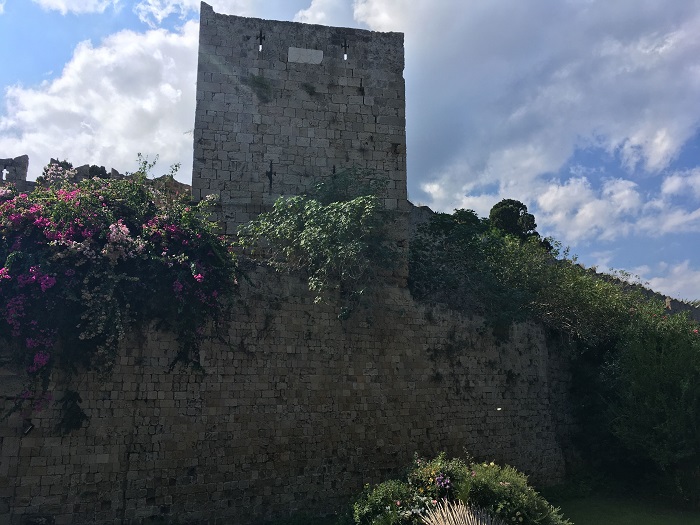
Join me to explore more of old Rhodes Town, including the Turkish quarter where the writer Lawrence Durrell lived and mused upon history.
NOTE: Since our recent trip to Greece to research more settings for my novel-in-progress, THE ARIADNE DISCONNECT, Thor and I knew we had to return to this magical region. My first entry in this new blog series posted here on Saturday, 10/20/2018. It gives an overview of our rambles from Athens to seven islands in the Dodecanese and Cyclades groups, ending our ferry-hopping pilgrimage on the anciently sacred island of Delos.
When Thor and I returned to Rhodos Town, I wanted to see the Turkish Quarter at the harbor, where Lawrence Durrell lived while stationed there by the British to help with post-World War II recovery. He named his rented house Villa Cleobolus for the ancient Greek sage.
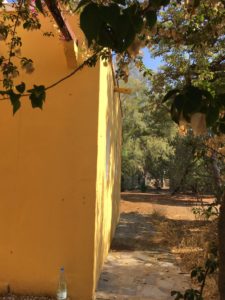
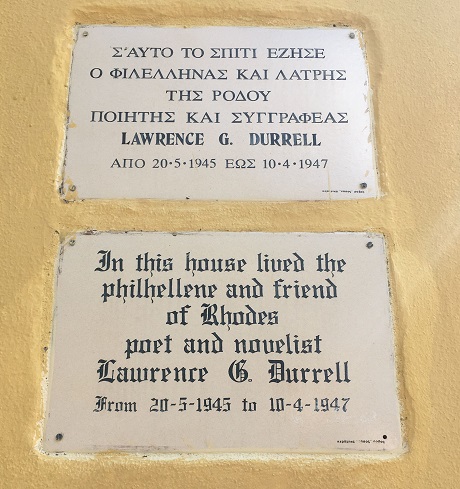
The villa, now closed, is located near the harbor market, within the walled grounds of an old Turkish cemetery.
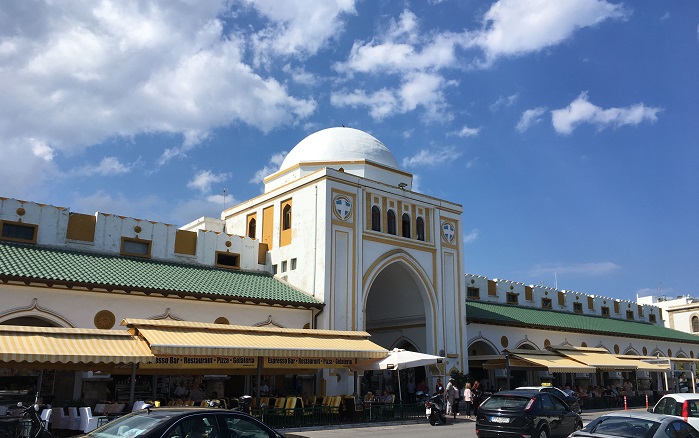
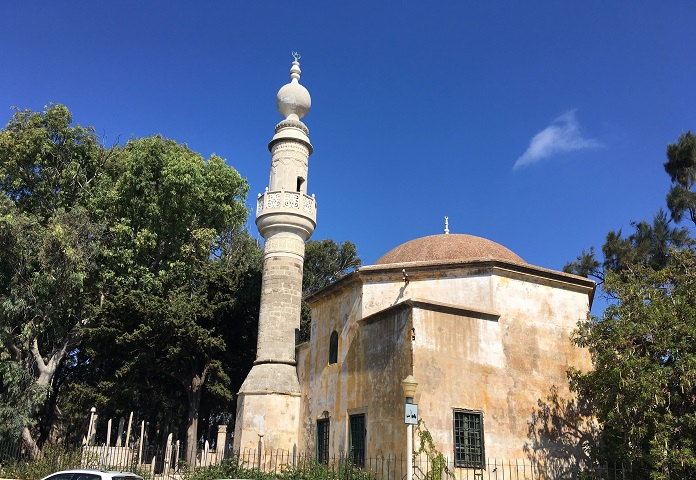
Durrell, who had spent many happier years in Greece, pre-war, wrote the memoir Reflections on a Marine Venus about his time on Rhodes, and while evoking the timeless beauty of the island and Greek history, it radiates melancholy about so much that was lost. Amid the chaos of postwar damage, deprivation, and recovery work, the quiet hours at the villa were precious:
“It is difficult to convey the extraordinary silence of this garden, for it is true that the main road runs along the length of it, and that the noises of motors can be heard; but so dense is the packing of oleanders and small pines and so heavy the shadow in which the house is set that sound itself becomes blurred and mingles with the hushing of the sea along the beaches to the eastward. Here in the evening we gather for drinks and gossip, sitting in cane chairs around the little painted table, hearing through the dusk the shallow strains of some forgotten fugue wafted to us from the old horn-gramophone which is the Mufti’s special pride.”
And: “Though it still lies on the site of the Grand Master’s garden, its appearance must have changed a least a dozen times since those days. Nevertheless the little groups of tombs like sentry-boxes, the marble gravestones with their flowing Arabic inscriptions, make a not ineffective monument to that lost epoch…. The grove of eucalyptus trees towers over them all, the drifts of autumn leaves rain down on them.”
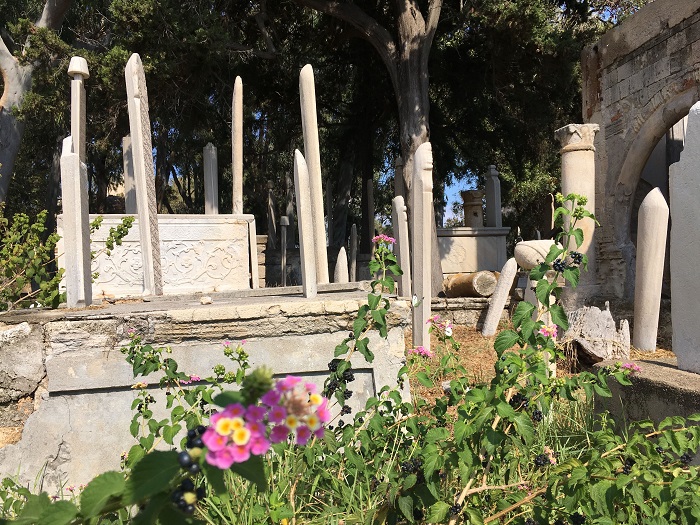
As always, a Greek cat completes the picture.
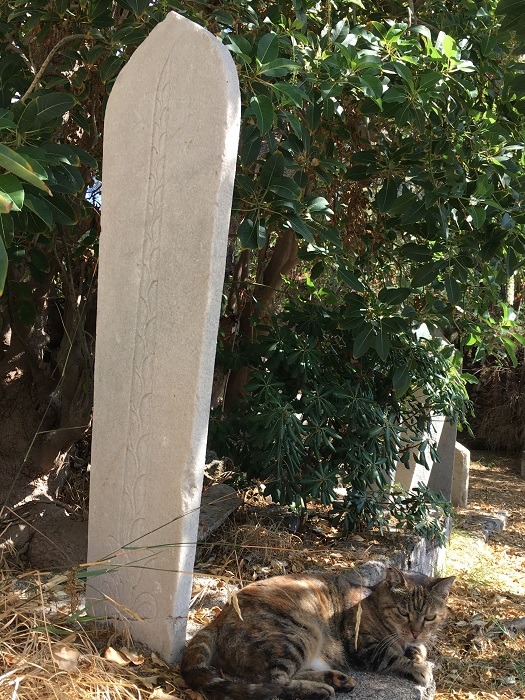
Before the war and German occupation, the Fascist Italians had controlled the island and had completed many excavations and reconstructions of historic sites. Durrell was not a fan of the Italians’ taste in the reconstruction of the Palace of the Grand Master of the Knights of St. John, who built the medieval walls.
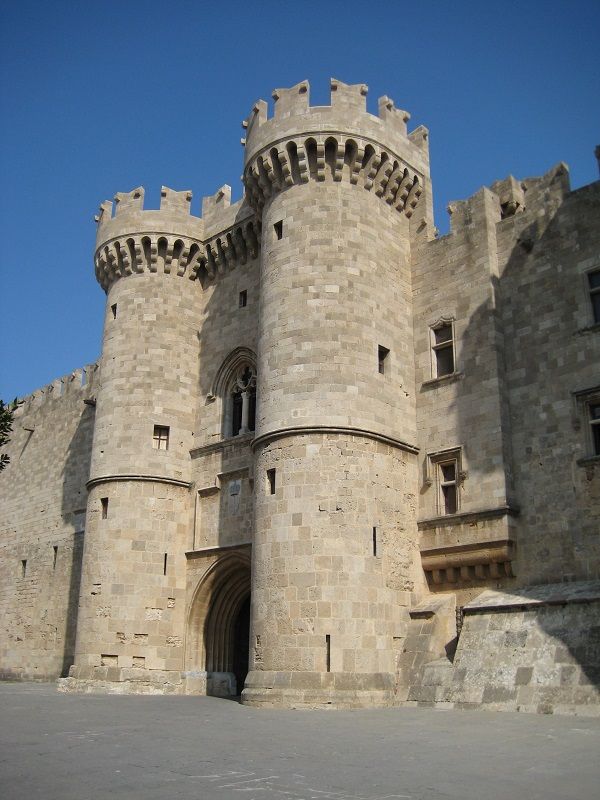
In his memoir, Durrell tours the edifice, which he calls the Castello:
“We pursued our way across the deserted market-place and entered the old walled town of the Crusaders, passing by the lovely and undamaged Gothic tower of St. Paul. At the spur of a gentle incline we turned into the famous Street of the Knights at the top of which lay the Castello–that monument to bad taste executed by the latest Italian governor. By now the hideous archness of the restoration work was becoming fully apparent…. We walked from room to garish room, from chapel to chapel, corridor to corridor; wherever you turned you were greeted with ugly statuary, tasteless hangings and tapestries, and the kind of marquetry work that suggested the lounges of passenger steamers.”
Here’s an example of the taste he was describing:
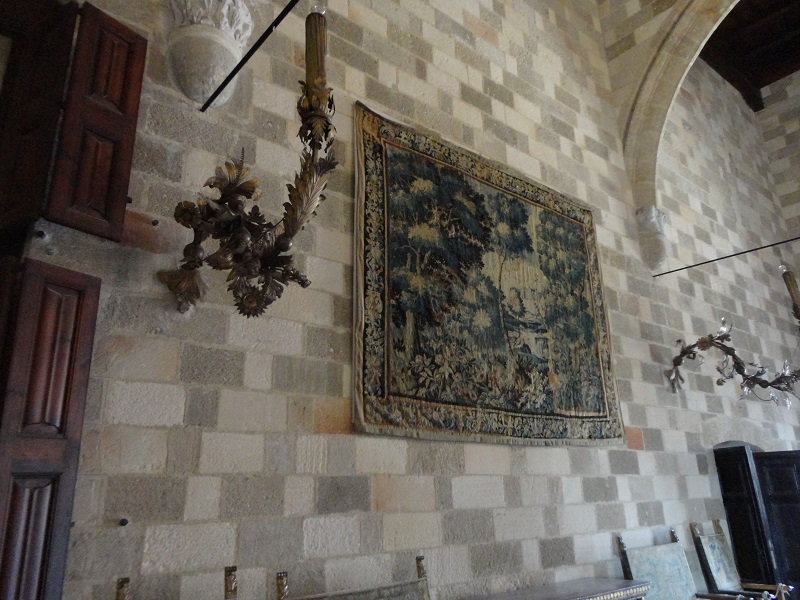
Despite the jumble of styles, the palace contains many exquisite Hellenic mosaics that the Italians took from the nearby island of Kos, including the famous Medusa. According to the myth, the monstrous Gorgon with hair of serpents would turn to stone anyone who looked at her. Thor and I survived!
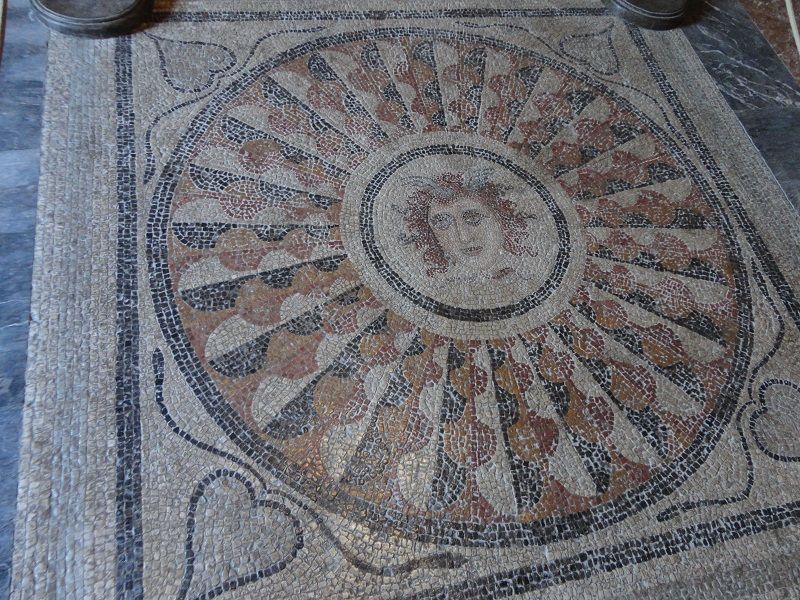
We visited the nearby temple site of very different deity, Aphrodite the goddess of love.
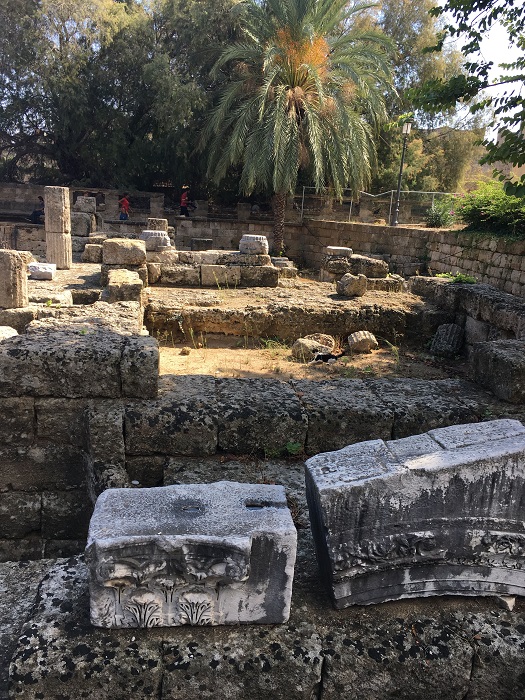
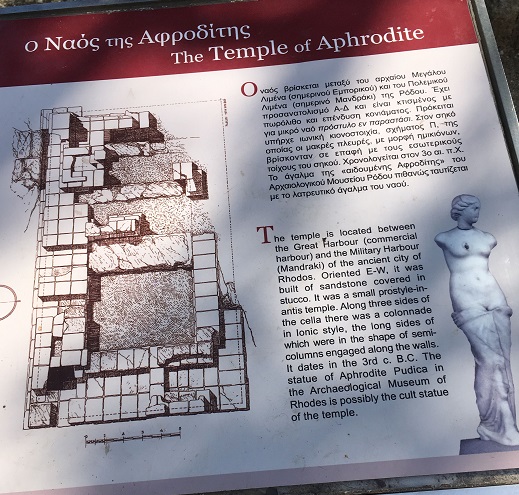
My first priority at the Rhodes archaeology museum was to see the statue of Aphrodite (Roman Venus) that inspired more of Durrell’s musings. The marble statue of the bathing goddess, carved in the 2nd-century AD, lay for centuries at the bottom of the Rhodes harbor, until fishermen snagged her in their net and hauled in an unexpected catch:
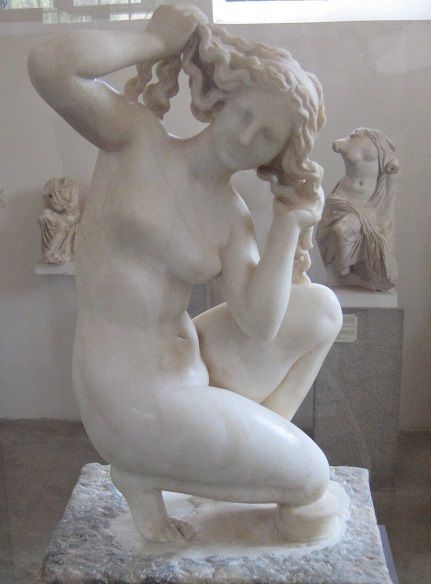
The reason why permitted areas for scuba diving are strictly controlled in Greek waters is the many statues and other artifacts still being found in the seas. When Durrell was posted by the British to Rhodes to run a newspaper in the post-war years, he witnessed the second “rising” of the statue from a cellar where she had been stored for protection:
“When the pulleys finally raised her out of the darkness, slowly twisting on the end of her cable–why, which of us could fail to recognise the presiding genius of the place…? She rose as if foamborn, turning that elegant body slowly from side to side, as if bowing to her audience. The sea-water had sucked at her for centuries till she was like some white stone jujube, with hardly a feature sharp as the burin must originally have left it. Yet such was the grace of her composition–the slender neck and breasts on that richly modelled torso, the supple line of arm and thigh–that the absence of firm outline only lent her a soft and confusing grace…. She sits in the Museum of the island now, focused intently upon her own inner life, gravely meditating upon the works of time. So long as we are in this place we shall not be free from her; it is as if our thoughts must be forever stained by some of her own dark illumination–the preoccupation of a stone woman inherited from a past whose greatest hopes and ideals fell to ruins. Behind and through her the whole idea of Greece glows sadly, like some broken capital, like the shattered pieces of a graceful jar, like the torso of a statue to hope.”
Durrell’s melancholy, witnessing the damage of the war years both physically and emotionally to his beloved Greece and, indeed, to all of Europe, is understandable. I had a very different reaction to the glowing presence of this Aphrodite, marveling at the echoes of beauty and grace enduring down the centuries.
Next week: Join us for a tour of the ancient city of Kameiros on Rhodes, one of the best-preserved in the region.
*****
You will find The Rambling Writer’s blog posts here every Saturday. Sara’s latest novel from Book View Cafe is available in print and ebook: The Ariadne Connection. It’s a near-future thriller set in the Greek islands. “Technology triggers a deadly new plague. Can a healer find the cure?” The novel has received the Chanticleer Global Thriller Grand Prize and the Cygnus Award for Speculative Fiction. Sara has recently returned from another research trip in Greece and is back at work on the sequel, The Ariadne Disconnect. Sign up for her quarterly email newsletter at www.sarastamey.com

Thanks and congrats!!cheap essay
I spent some time on the island of Rhodos in the late 1980’s, Lawrence Durrell was always one of my favourite authors although at the time I was there, I did not know the connection! Thanks for this article, I look forward to getting hold of your book. I am in Cape Town South Africa Terry
Thanks, Terry! I hope you enjoy the novel — let me know if you get a chance.
Dear Sara, I hope you will read my review and will be pleasantly amazed that I’ve meet the same cat, passing by the cemetery, he just grabbed my attention by a greeting me with a looonggg sweeet “may”… afterwards I’I’ve petted him, we had a good exchange of vibes, he was inpatient to tell me lots of his stories… and I loved to hire some of them. 11/00/2022
Hello, Larisa. I hope you write those stories the cat imparted! A magical place.
Muslim Cemetery at Rhodes and it’s Cat
Such a lovely spot, with cat of course.
Dear Sara, after many visits to Rhodes and the Villa Cleobolus, we were back again today. One year it was actually opened and occupied by the arts group and they kindly let us tour it and photograph inside. Closed today but a window was broken and I took pics of the interior. I’ll try to attach a few. Enjoy your blog, keep up the good work!
BTW. The Marine Venus you photographed isn’t the one Durrell referenced. It is in the next room, standing, a bit larger than life sized with a curious blemish on her chest. A pocket watch landed on her and decomposed leaving a distinct rust spot in the shape of the watch. YouTube has Durrells filmed mid 70’s recollections of Greece titled “Spirit of Place” in which he’s in the Rhodes museum standing next to the Venus and explains it’s not the bathing crouched Venus but the tall one with the blemish and in indistinct features like a sucked juju candy. You aren’t the first to make the mistake as the crouched one does have a name like marine Venus. But Durrell makes it clear.
Thanks for your interest in his work.
I tried but was unable to attach photos on the interior I took today but it didn’t work. Let me know if you want any and what method I can send.
Gary, thanks so much for the information and alert about the Marine Venus. I need to go through my photos to see if I snapped one of the tall one.